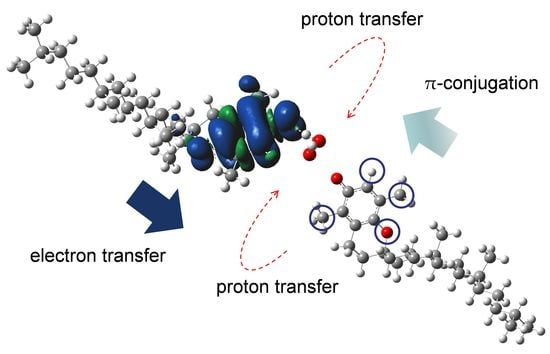Electrochemical and Mechanistic Study of Reactivities of α-, β-, γ-, and δ-Tocopherol toward Electrogenerated Superoxide in N,N-Dimethylformamide through Proton-Coupled Electron Transfer
Abstract
:1. Introduction
2. Materials and Methods
2.1. Chemicals
2.2. Electrochemical and In Situ Electrolytic ESR Spectrum Measurements
2.3. Calculation
3. Results
3.1. Cyclic Voltammetry and ESR Analysis of O2/O2•− in the Presence of TOH
3.2. CV Analyses of the PCET between O2•− and α-TOH under Acid-Base Interactions
3.3. Free Energy Calculations of PCET between Electrogenerated O2•− and TOH
3.4. Potential Energy Scanning for the Stable HB Complex along the PCET
3.5. Effect of para-Oxygen in the 6-Chromanol Ring of TOH on the O2•− Scavenging
4. Conclusions
- β- and γ-TOH scavenges O2•− through the PCET involving two PTs and one ET, with a similar mechanism for α-TOH; conversely, δ-TOH does not do so;
- A feasible PCET mechanism for α-, β-, and γ-TOH is that the initial PT forms a 1:2 HB complex (TO−–HO2•–TOH) followed by intermolecular ET–PT as an intra-complex reaction;
- The increasing number of methyl groups on a 6-chromanol ring promotes the PCET reaction, especially the latter ET–PT, increasing the electron-donating ability of the 6-chromanol ring;
- The expansion of the π-conjugated plane via the 1:2 HB complex plays an important role in the PCET mechanism;
- The electron-donating ability of the para-oxygen-atom in the 6-chromanol ring of TOH is essential for successful O2•− scavenging through the PCET.
Supplementary Materials
Author Contributions
Funding
Institutional Review Board Statement
Informed Consent Statement
Data Availability Statement
Conflicts of Interest
References
- Sen, C.K.; Khanna, S.; Roy, S. Tocotrienols: Vitamin E beyond tocopherols. Life Sci. 2006, 78, 2088–2098. [Google Scholar] [CrossRef] [PubMed] [Green Version]
- Sen, C.K.; Khanna, S.; Roy, S. Tocotrienols in health and disease: The other half of the natural vitamin E family. Mol. Aspects Med. 2007, 28, 692–728. [Google Scholar] [CrossRef] [PubMed] [Green Version]
- Lee, S.B.; Lin, C.Y.; Gill, P.M.W.; Webster, R.D. Transformation of α-tocopherol (vitamin E) and related chromanol model compounds into their phenoxonium ions by chemical oxidation with the nitrosonium cation. J. Org. Chem. 2005, 70, 10466–10473. [Google Scholar] [CrossRef]
- Lehtovuori, P.; Joela, H. Radical cations of vitamin E. Phys. Chem. Chem. Phys. 2002, 4, 1928–1933. [Google Scholar] [CrossRef]
- Musialik, M.; Litwinienko, G. Scavenging of dpph• radicals by vitamin E is accelerated by its partial ionization: The role of sequential proton loss electron transfer. Org. Lett. 2005, 7, 4951–4954. [Google Scholar] [CrossRef] [PubMed]
- Wilson, G.J.; Lin, C.Y.; Webster, R.D. Significant differences in the electrochemical behavior of the α-, β-, γ-, and δ-tocopherols (vitamin E). J. Phys. Chem. B 2006, 110, 11540–11548. [Google Scholar] [CrossRef] [PubMed]
- Malyszko, J.; Karbarz, M. Electrochemical oxidation of trolox and α-tocopherol in acetic acid: A comparative study. J. Electroanal. Chem. 2006, 595, 136–144. [Google Scholar] [CrossRef]
- Williams, L.L.; Webster, R.D. Electrochemically controlled chemically reversible transformation of α-tocopherol (vitamin E) into its phenoxonium cation. J. Am. Chem. Soc. 2004, 126, 12441–12450. [Google Scholar] [CrossRef]
- Yao, W.W.; Peng, H.M.; Webster, R.D. Electrochemistry of α-tocopherol (Vitamin E) and α-tocopherol quinone films deposited on electrode surfaces in the presence and absence of lipid multilayers. J. Phys. Chem. C 2009, 113, 21805–21814. [Google Scholar] [CrossRef]
- Hong, M.P.; Webster, R.D. Investigation into phenoxonium cations produced during the electrochemical oxidation of chroman-6-ol and dihydrobenzofuran-5-ol substituted compounds. J. Org. Chem. 2008, 73, 2169–2175. [Google Scholar] [CrossRef]
- Costentin, C.; Robert, M.; Savéant, J.M. Electrochemical and homogeneous proton-coupled electron transfers: Concerted pathways in the one-electron oxidation of a phenol coupled with an intramolecular amine-driven proton transfer. J. Am. Chem. Soc. 2006, 128, 552–4553. [Google Scholar] [CrossRef]
- Costentin, C.; Robert, M.; Savéant, J.M. Concerted proton-electron transfers: Electrochemical and related approaches. Acc. Chem. Res. 2010, 43, 1019–1029. [Google Scholar] [CrossRef] [PubMed]
- Wenger, O.S. Proton-coupled electron transfer with photoexcited metal complexes. Acc. Chem. Res. 2013, 46, 1517–1526. [Google Scholar] [CrossRef] [Green Version]
- Hammes-Schiffer, S. Theory of proton-coupled electron transfer in energy conversion processes. Acc. Chem. Res. 2009, 42, 1881–1889. [Google Scholar] [CrossRef] [PubMed] [Green Version]
- Koper, M.T.M. Theory of the transition from sequential to concerted electrochemical proton-electron transfer. Phys. Chem. Chem. Phys. 2013, 15, 1399–1407. [Google Scholar] [CrossRef] [PubMed] [Green Version]
- Litwinienko, G.; Ingold, K.U. Solvent effects on the rates and mechanisms of reaction of phenols with free radicals. Acc. Chem. Res. 2007, 40, 222–230. [Google Scholar] [CrossRef]
- Nakayama, T.; Uno, B. Importance of proton-coupled electron transfer from natural phenolic compounds in superoxide scavenging. Chem. Pharm. Bull. 2015, 63, 967–973. [Google Scholar] [CrossRef] [PubMed] [Green Version]
- Nakayama, T.; Uno, B. Quinone-hydroquinone π-conjugated redox reaction involving proton-coupled electron transfer plays an important role in scavenging superoxide by polyphenolic antioxidants. Chem. Lett. 2010, 39, 162–164. [Google Scholar] [CrossRef]
- Nakayama, T.; Uno, B. Concerted two-proton-coupled electron transfer from catechols to superoxide via hydrogen bonds. Electrochim. Acta 2016, 208, 304–309. [Google Scholar] [CrossRef]
- Nakayama, T.; Uno, B. Structural properties of 4-substituted phenols capable of proton-coupled electron transfer to superoxide. Int. J. Adv. Res. Chem. Sci. 2016, 3, 11–19. [Google Scholar] [CrossRef]
- Okumura, N.; Uno, B. Electronic spectra of the electrogenerated 1,4-benzoquinone π-dianion and the strongly hydrogen-bonded charge-transfer complex with methanol. Bull. Chem. Soc. Jpn. 1999, 72, 1213–1217. [Google Scholar] [CrossRef]
- Frisch, G.W.; Schlegel, H.B.; Scuseria, G.E.; Robb, M.A.; Cheeseman, J.R.; Scalmani, G.; Barone, V.; Petersson, G.A.; Nakatsuji, H.; Li, X.; et al. Gaussian 16, Rev. B.01; Gaussian, Inc.: Wallingford, CT, USA, 2016; ISBN 9781935522027. [Google Scholar]
- Quintero-Saumeth, J.; Rincón, D.A.; Doerr, M.; Daza, M.C. Concerted double proton-transfer electron-transfer between catechol and superoxide radical anion. Phys. Chem. Chem. Phys. 2017, 19, 26179–26190. [Google Scholar] [CrossRef] [PubMed]
- Reed, A.E.; Weinstock, R.B.; Weinhold, F. Natural population analysis. J. Chem. Phys. 1985, 83, 735–746. [Google Scholar] [CrossRef]
- Song, C.; Zhang, J. Electrocatalytic oxygen reduction reaction. In PEM Fuel Cell Electrocatalysts and Catalyst Layers: Fundamentals and Applications; Springer: Berlin, Germany, 2008; pp. 89–134. ISBN 9781848009356. [Google Scholar]
- Singh, P.S.; Evans, D.H. Study of the electrochemical reduction of dioxygen in acetonitrile in the presence of weak acids. J. Phys. Chem. B 2006, 110, 637–644. [Google Scholar] [CrossRef] [PubMed]
- Mukai, K.; Tsuzuki, N.; Ishizu, K.; Ouchi, S.; Fukuzawa, K. Electron spin resonance and electron nuclear double resonance studies of cation radicals derived from tocopherol model compounds. Chem. Phys. Lipids 1984, 35, 199–208. [Google Scholar] [CrossRef]
- Matsuo, M.; Matsumoto, S. Electron spin resonance spectra of the chromanoxyl radicals derived from tocopherols (vitamin E) and their related compounds. Lipids 1983, 18, 81–86. [Google Scholar] [CrossRef]
- Valoti, M.; Sipe, H.J.; Sgaragli, G.; Mason, R.P. Free radical intermediates during peroxidase oxidation of 2-t-butyl-4-methoxyphenol, 2,6-di-t-butyl-4-methylphenol, and related phenol compounds. Arch. Biochem. Biophys. 1989, 269, 423–432. [Google Scholar] [CrossRef]
- Mukai, K.; Nishiguchi, H.; Ishizu, K.; Deguchi, Y.; Takaki, H. Solvent Effects in the Electron Spin Resonance Spectra of Some Phenoxyl, Nitroxide, and Anilino Radicals. Bull. Chem. Soc. Jpn. 1967, 40, 2731–2739. [Google Scholar] [CrossRef]
- Hammett, L.P. The Effect of Structure upon the Reactions of Organic Compounds. Benzene Derivatives. J. Am. Chem. Soc. 1937, 59, 96–103. [Google Scholar] [CrossRef]
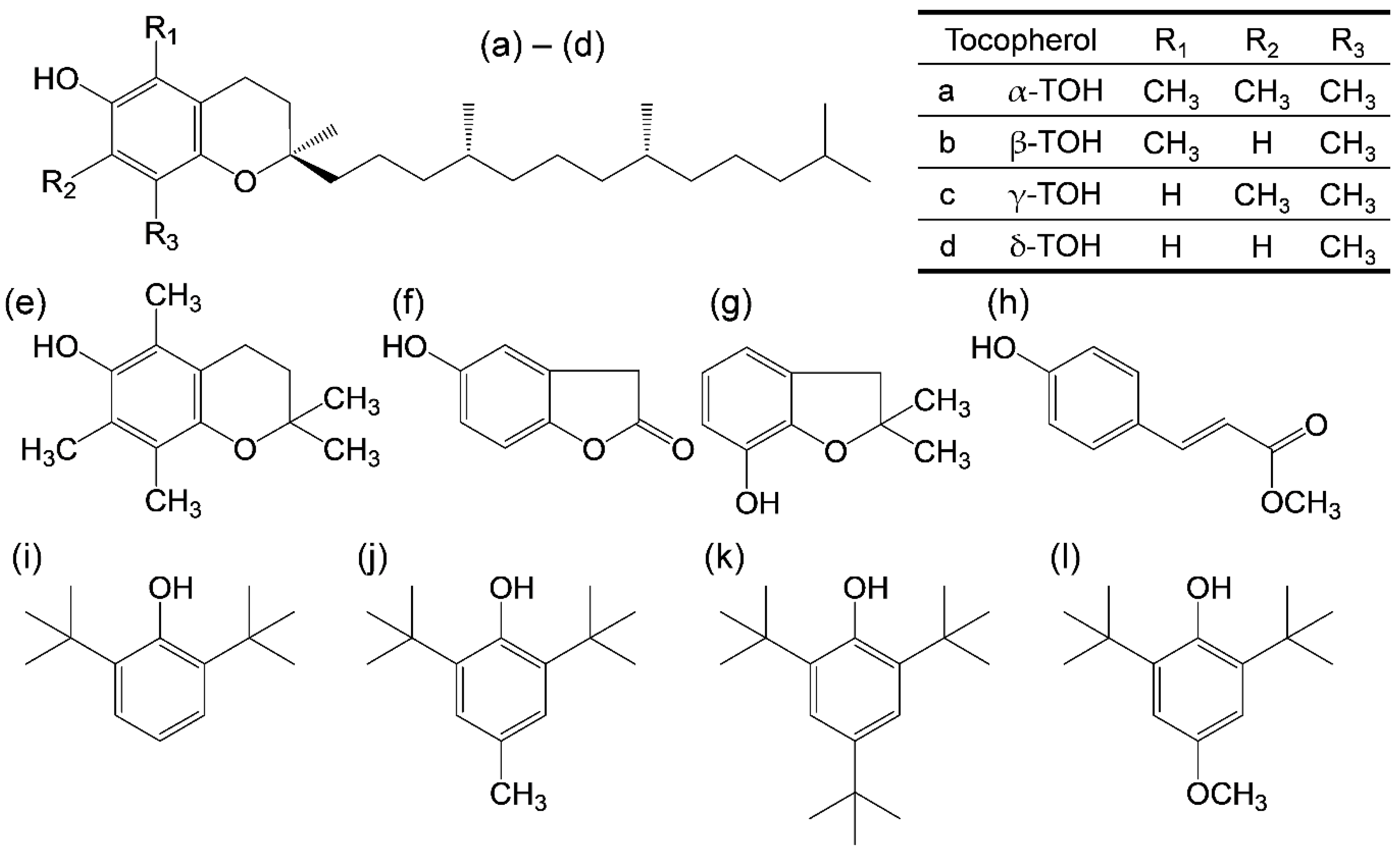
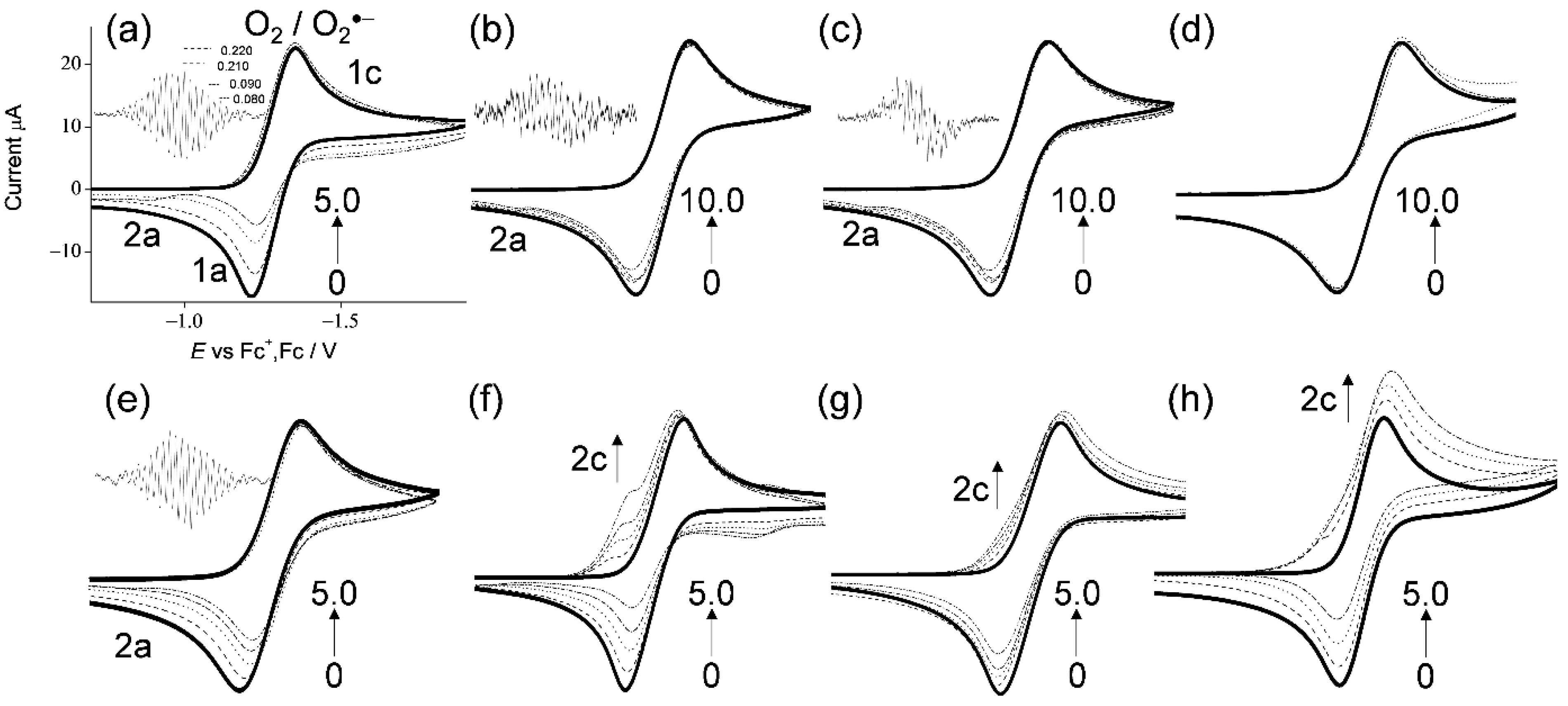


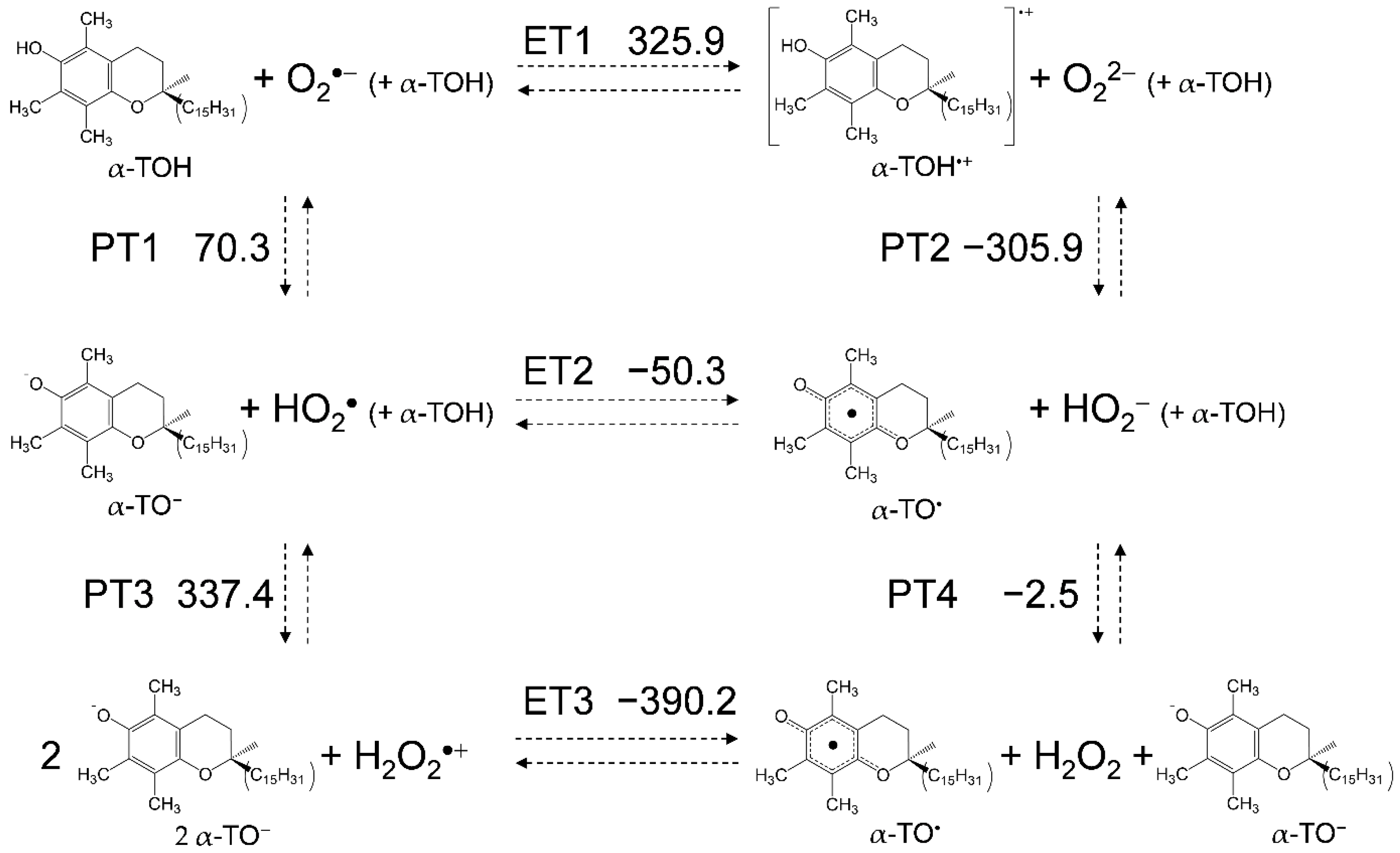
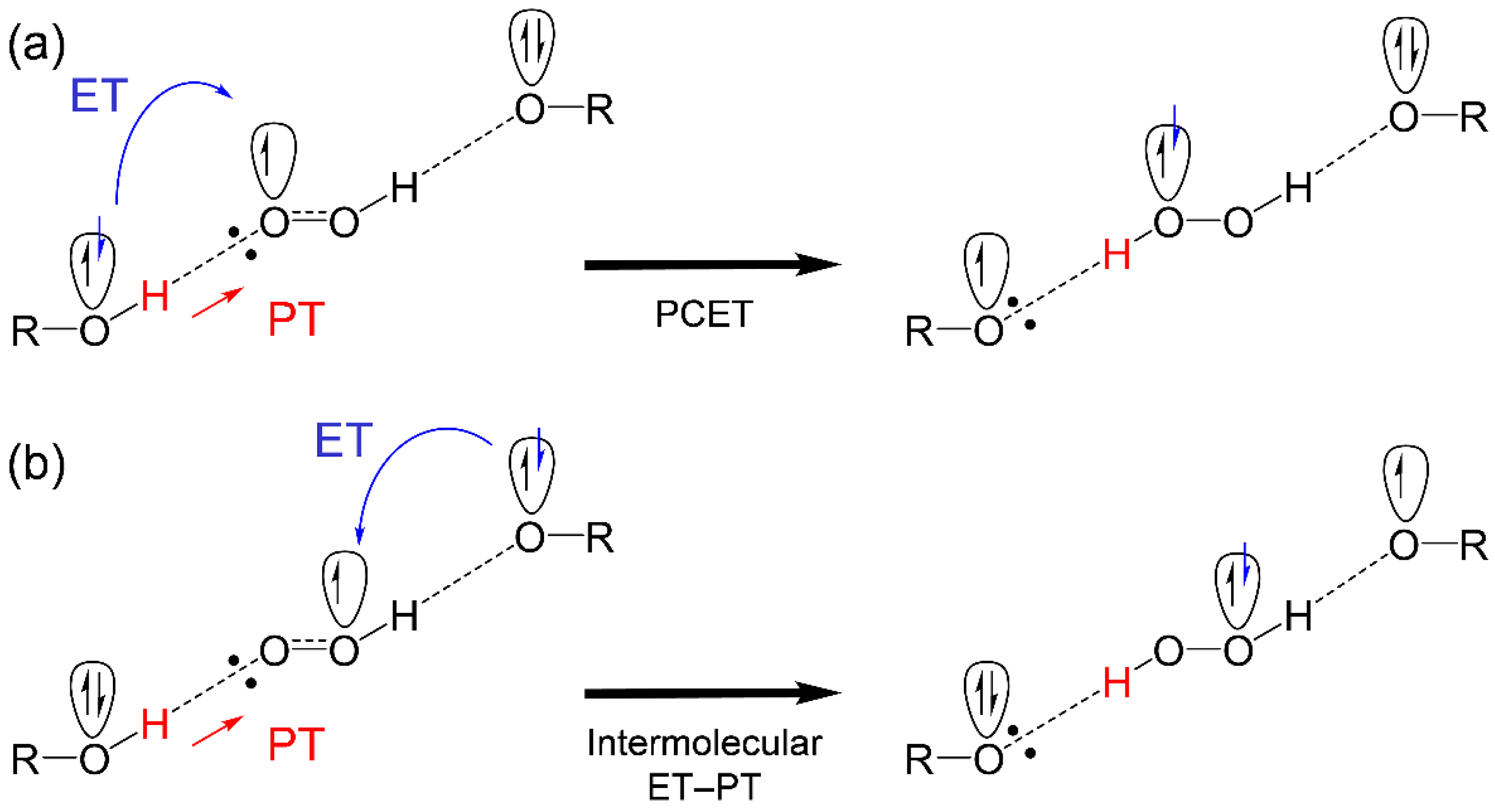
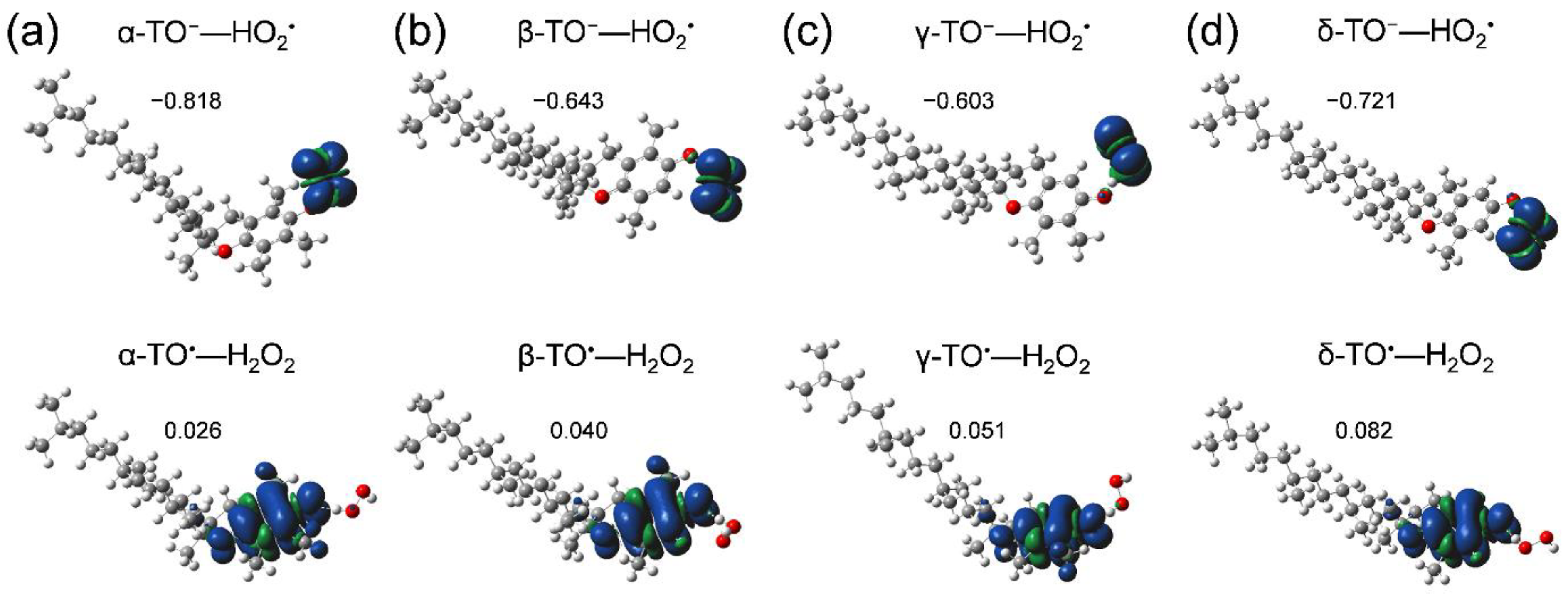
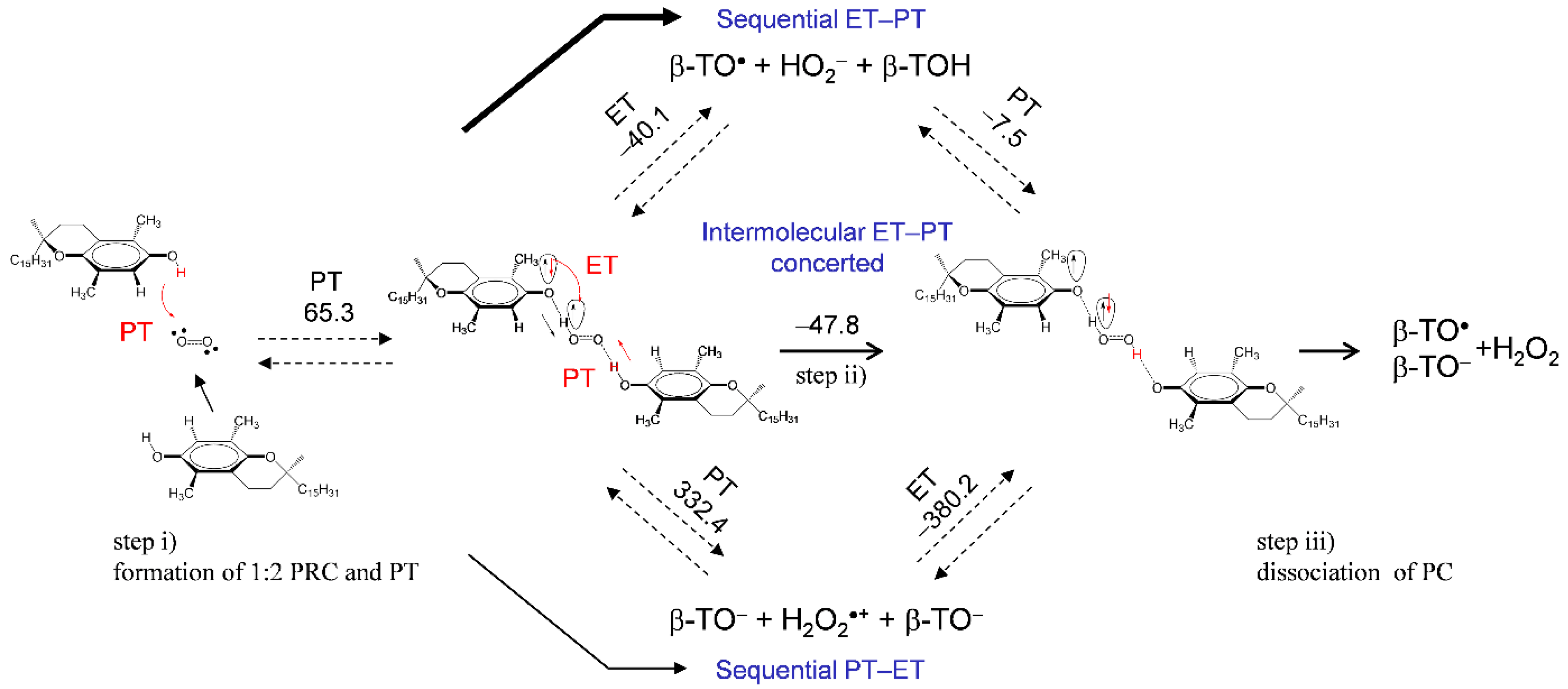
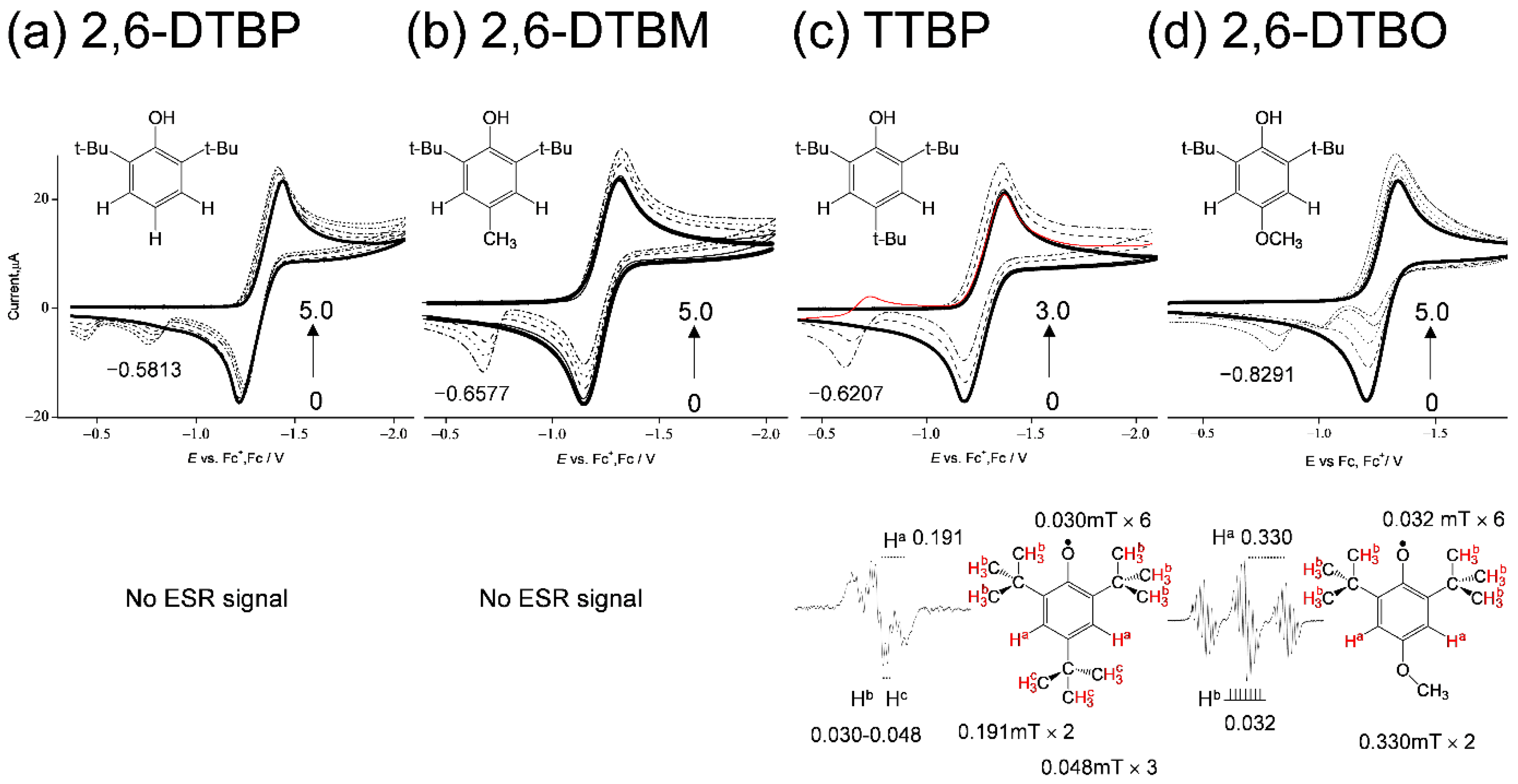
| Compounds | PT1 | PT2 | PT3 | PT4 | ET1 | ET2 | ET3 | Total 1 |
|---|---|---|---|---|---|---|---|---|
| α-TOH | 70.3 | −305.9 | 337.4 | −2.5 | 325.9 | −50.3 | −390.2 | 17.4 |
| β-TOH | 65.3 | −303.4 | 332.4 | −7.5 | 328.6 | −40.1 | −380.2 | 17.5 |
| γ-TOH | 62.9 | −312.3 | 330.0 | −9.9 | 336.6 | −38.6 | −378.5 | 14.4 |
| δ-TOH | 62.2 | −308.6 | 329.2 | −10.7 | 342.3 | −28.4 | −368.5 | 22.9 |
| 2,2,5,7,8-pentamethyl-6-chromanol | 68.3 | −306.3 | 335.4 | −4.6 | 325.5 | −49.1 | −389.1 | 14.5 |
| homogentisic acid γ-lactone | 38.4 | −349.4 | 305.5 | −34.4 | 408.6 | 20.7 | −319.2 | 24.8 |
| 2,3-dihydro-2,2-dimethyl-7-hydroxybenzofuran | 48.3 | −332.6 | 315.4 | −37.6 | 387.4 | 6.5 | −346.5 | 17.1 |
| trans-para-coumaric acid | 7.9 | −249.6 | 275.0 | −65.0 | 413.4 | 155.8 | −184.1 | 98.7 |
| Compounds | 1 ΔΔG° (kJ mol−1) | 2E° (V vs. SHE) | 3 ΔE (V vs. EDTBP) |
|---|---|---|---|
| α-TOH | −349.3 | 3.620 | −0.494 |
| β-TOH | −359.5 | 3.726 | −0.389 |
| γ-TOH | −361.1 | 3.742 | −0.373 |
| δ-TOH | −371.2 | 3.847 | −0.268 |
| 2,6-DTBP | −397.1 | 4.115 | 0 |
| 2,6-DTBM | −380.1 | 3.939 | −0.176 |
| TTBP | −381.6 | 3.955 | −0.160 |
| 2,6-DTBO | −366.2 | 3.795 | −0.319 |
Publisher’s Note: MDPI stays neutral with regard to jurisdictional claims in published maps and institutional affiliations. |
© 2021 by the authors. Licensee MDPI, Basel, Switzerland. This article is an open access article distributed under the terms and conditions of the Creative Commons Attribution (CC BY) license (https://creativecommons.org/licenses/by/4.0/).
Share and Cite
Nakayama, T.; Honda, R.; Kuwata, K.; Usui, S.; Uno, B. Electrochemical and Mechanistic Study of Reactivities of α-, β-, γ-, and δ-Tocopherol toward Electrogenerated Superoxide in N,N-Dimethylformamide through Proton-Coupled Electron Transfer. Antioxidants 2022, 11, 9. https://doi.org/10.3390/antiox11010009
Nakayama T, Honda R, Kuwata K, Usui S, Uno B. Electrochemical and Mechanistic Study of Reactivities of α-, β-, γ-, and δ-Tocopherol toward Electrogenerated Superoxide in N,N-Dimethylformamide through Proton-Coupled Electron Transfer. Antioxidants. 2022; 11(1):9. https://doi.org/10.3390/antiox11010009
Chicago/Turabian StyleNakayama, Tatsushi, Ryo Honda, Kazuo Kuwata, Shigeyuki Usui, and Bunji Uno. 2022. "Electrochemical and Mechanistic Study of Reactivities of α-, β-, γ-, and δ-Tocopherol toward Electrogenerated Superoxide in N,N-Dimethylformamide through Proton-Coupled Electron Transfer" Antioxidants 11, no. 1: 9. https://doi.org/10.3390/antiox11010009
APA StyleNakayama, T., Honda, R., Kuwata, K., Usui, S., & Uno, B. (2022). Electrochemical and Mechanistic Study of Reactivities of α-, β-, γ-, and δ-Tocopherol toward Electrogenerated Superoxide in N,N-Dimethylformamide through Proton-Coupled Electron Transfer. Antioxidants, 11(1), 9. https://doi.org/10.3390/antiox11010009






